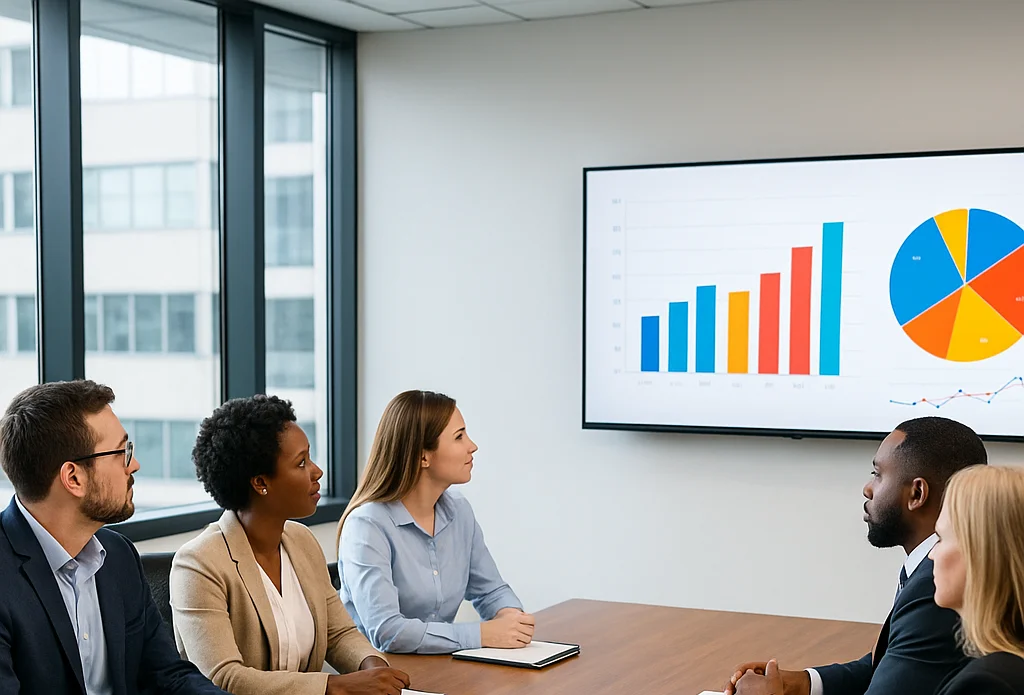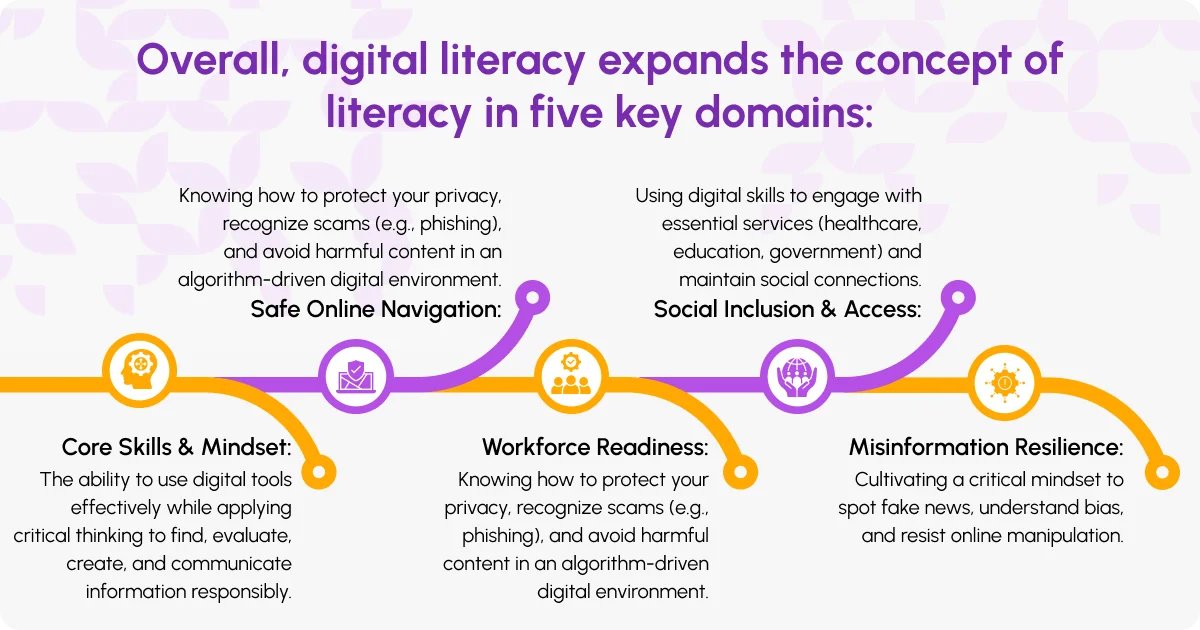- L&D INSIGHTS/
- Literacy vs Digital Literacy: What Are the Differences?/


Literacy vs Digital Literacy: What Are the Differences?
- L&D INSIGHTS/
- Literacy vs Digital Literacy: What Are the Differences?/
Literacy vs Digital Literacy: What Are the Differences?
Smartphones, social media, and constant connectivity have made digital literacy just as essential as traditional reading and writing skills. It's all about having the right know-how to confidently navigate and make sense of the digital world—whether at home, at work, or in your community. Teachers and leaders everywhere now understand that true literacy today goes hand-in-hand with digital skills.
In this article, we will explore the relationship between literacy and digital literacy, their similarities and differences and suggest ways you can quickly and easily improve your digital skillset.
History and Evolution of Literacy and Digital Literacy
Historically, “literacy” meant the ability to read and write text. The term digital literacy itself rose to prominence in the 1990s and has been constantly evolving since then.
Back in the day, terms like "computer literacy" or "ICT literacy" mainly meant knowing your way around a computer or a piece of software. But we've realized there's much more to digital literacy than just clicking buttons. It's also about understanding how to find reliable information online (information literacy) and decoding the messages we see in media (media literacy).
By the 2010s, digital literacy wasn't just academic jargon anymore—it became a key focus for educators and policymakers worldwide. Schools in many countries started making digital literacy a core part of their teaching. As researcher Julian Sefton-Green noted, we've moved beyond seeing digital literacy as just technical know-how; now it's recognized as a deeper set of skills essential for life in today's digital-first world.
Understanding the Relationship Between Literacy and Digital Literacy
It goes without saying that digital literacy goes beyond traditional reading and writing. It means making sense of information presented in text, videos, podcasts, or interactive media. As digital literacy expert Paul Gilster points out, handling internet content is a different beast because "it's not all text... it's multidimensional and interactive."
Today, UNESCO defines digital literacy as the “ability to access, manage, understand, integrate, communicate, evaluate and create information safely and appropriately through digital technologies for employment, decent jobs and entrepreneurship.” Clearly, the whole idea of literacy has broadened, reflecting our digital-first world.
Overall, digital literacy expands the concept of literacy in five key domains:
- Core Skills & Mindset: The ability to use digital tools effectively while applying critical thinking to find, evaluate, create, and communicate information responsibly.
- Safe Online Navigation: Knowing how to protect your privacy, recognize scams (e.g., phishing), and avoid harmful content in an algorithm-driven digital environment.
- Workforce Readiness: Possessing baseline digital competencies required by most employers, which expand job opportunities and potential earnings.
- Social Inclusion & Access: Using digital skills to engage with essential services (healthcare, education, government) and maintain social connections.
- Misinformation Resilience: Cultivating a critical mindset to spot fake news, understand bias, and resist online manipulation.

Digital Literacies: Making Sense of the Different Terms
When we discuss literacy and digital literacy, several related terms often surface – digital skills, digital competences, digital fluency, and more. Making sense of the terminology is particularly important, if you are working in the sphere of business development and/or education.
Digital Literacy As An Umbrella Term
Think of digital literacy as a big umbrella. It encompasses everything from basic skills like using a mouse and finding reliable information online, to engaging responsibly in social networks or contributing positively to digital spaces. It’s a broad idea that overlaps with many “sister” terms: computer literacy, information literacy, media literacy, ICT literacy, etc., which are all aspects of the wider digital literacy picture.
Computer Literacy vs. Digital Literacy
It's helpful to understand that computer literacy and digital literacy, while related, aren't exactly the same thing. When someone is computer literate, they have basic tech skills—like typing documents, browsing websites, installing apps, or troubleshooting simple computer issues. Digital literacy, however, includes the ability to find, judge, create, and share digital content effectively, along with understanding issues, such as online privacy, misinformation, and responsible digital behavior.
Digital Skills
When we talk about"digital skills", we're usually focusing on the practical, hands-on abilities to use technology. This can mean simple things like typing, browsing the web, or finding information online, or more advanced skills like coding, data analysis, and graphic design. Think of digital skills as the foundational building blocks—essential, yes, but still just one part of the bigger picture that makes up full digital literacy.
Digital Competence
In Europe, you'll often hear the term"digital competence”, which is an important part of the debate about literacy and digital literacy. According to the EU's Digital Competence Framework (DigComp), digital competence means confidently and critically using all kinds of digital tools—for communication, finding information, and solving everyday problems. It's about more than just knowing how to use technology; it involves understanding digital environments and approaching them responsibly.
Digital Fluency
Digital literacy ties closely into what's known as "21st-century skills"—things like critical thinking, creativity, teamwork, and effective communication. All these skills now include a digital element, meaning you need to apply them online as well as offline. Some educators go a step further and talk about"digital fluency”, describing a level of comfort where using digital tools feels as natural as breathing, and adapting to new technology comes easily.
Whether you are interested in improving your digital literacy, fluency or skills, Future Savvy’s course might be just what you are looking for.Contact us today!
Digital Literacies
Researchers frequently talk about "digital literacies”. For example, Professor Gianfranco Polizzi splits digital literacy into two key parts: functional and critical. Functional digital literacy covers the practical stuff, like knowing how to use apps, websites, and digital tools. Critical digital literacy goes deeper; it's about being able to judge the quality and reliability of what you read online and understand how algorithms shape what we see or how our personal data is used.
Download our Training Needs Analysis Form
 Download now
Download nowDigital Literacy in Society: Digital Citizenship, Rights, and Participation Gaps
Despite its many advantages, there are several significant challenges surrounding digital literacy. Here we explore how it relates to issues of social inclusion, rights, and civic participation.
Digital Citizenship
One thing literacy and digital literacy have in common is how they provoke debates about rights and responsibilities. Digital citizenship is all about using technology responsibly and ethically and understanding your rights in the online world. In short, it’s about using tech for good, while staying safe and fair to everyone.
The Digital Divide
For instance, a significant minority remain offline or have very limited internet access even in the UK. In 2023, around 7% of UK households still had no internet at home. Not having digital skills or internet access can make life harder, cutting people off from jobs, government services, and even social interactions—deepening existing inequalities.
Access and Participation Gaps
This takes the "digital divide" idea further—beyond just who has internet—to include gaps in digital skills and social support. Imagine a classroom where everyone has internet, but some students struggle because they don't have strong digital skills or support at home. These "participation gaps" can deepen existing inequalities.
Digital Literacy and Democracy
Literacy and digital literacy are essential for a healthy democracy. As Dr. Harriett Steinbach points out, being digitally savvy helps keep democracy strong: when we know how to spot accurate information and share it responsibly, we’re doing our part as active and informed citizens.
Resilience to Online Harms
A key benefit of digital literacy is helping people build resilience against online threats like misinformation, hate speech, or extremist content. Today, libraries, schools, and local community groups often run media literacy programs to help people develop skills to spot and question misleading information. It's about empowering everyone to navigate the digital world safely and confidently.
Digital Literacy in the Workforce and Entrepreneurship
What about literacy and digital literacy in business?
In the UK, a 2019 study by Burning Glass Technologies similarly found “82% of jobs in the UK require digital skills”. This is why so many companies now run in-house workshops and online courses on hot skills like data analysis, digital marketing, and specialized software.
Here are seven things you can do today to make sure your digital literacy is not lagging behind:
- Tap free training: try public-library classes, Coursera, Google Digital Garage, or UK “Essential Digital Skills” courses.
- Learn by doing: set real goals—pay a bill online, back up photos, video-chat family—and pick up skills along the way.
- Start with beginner sites: GCFGlobal, Digital Learn, and Common Sense Media break down basics like mouse use and safe browsing.
- Lean on mentors: ask a tech-savvy friend or help a relative; patient, hands-on practice beats solo guesswork.
- Stay curious: question online info, practice smarter Googling, and build each new skill on the last.
- Join local groups: look for coding clubs, “senior surfers,” or library tech-help sessions for community support.
- Keep growing: digital literacy is lifelong—each new tool mastered makes the next one easier.
Bottom line: digital learning has become a lifelong affair, not something you finish when you leave school.

If you are looking to boost your digital skills, Future Savvy’s instructor-led training programs offer courses on Excel, PowerPoint, PowerBI and many other essential software packages. Check them out!
Download our Quick IT Course Guide
 Download now
Download nowFuture Trends: AI Literacy and Evolving Technology
The next logical step in the development of literacy and digital literacy is incorporating AI. AI is increasingly woven into the tools we use (from smart assistants and recommendation algorithms to generative AI like ChatGPT).
Researchers explain that “AI literacy has become a vital extension of digital literacy”, encompassing “an understanding of AI, the ability to use AI for enhanced value in daily life, and the development of critical thinking skills regarding AI”.
Being digitally savvy now means having a handle on AI too. We’ll all need the basics—how algorithms make choices, where bias can creep in, and when to trust or question AI-generated content. That could be as simple as double-checking an AI summary or confidently using AI tools in your daily workflow.
Just like mastering the internet became a staple of digital literacy in the 2000s, AI fluency is shaping up to be the next must-have skill.
We have seen that literacy and digital literacy have become deeply interwoven in recent years. Understanding and knowing how to use digital media and tools responsibly has become just as important as traditional reading and writing. Luckily, there is an abundance of resources that you can use to improve your digital skillset.
If you want to learn more, Future Savvy specialises in offering training to individuals and organisations that help them expand their existing knowledge and grow their business.
Frequently Asked Questions (FAQ)
This is likely "context truncation." The chat history is part of the context window, and as the conversation gets longer, earlier messages are pushed out to make room for new prompts and retrieved data. Start a new chat to reset the window with a fresh focus.
Use the in-app Copilot (e.g., in Word) with the document open. In M365 Chat, be explicit with your grounding: "Using only the document /path/to/Policy_v4.docx, answer the following..." This scopes the retrieval and prevents Copilot from searching your wider tenant.
The "context window" is the session's "working memory," which resets after the chat ends. Microsoft is also rolling out a "Memory" feature that allows Copilot to learn your preferences (e.g., writing style, common collaborators) persistently. This persistent memory helps shape future prompts but is separate from the token limit of a single conversation.
Microsoft does not publish a specific token number for M365 Copilot, as this changes with the underlying models. Instead, it provides practical guidance (as of Oct 2025): Copilot can retrieve from documents up to ~1.5 million words for summarisation, can rewrite ~3,000-word passages, and can ground a single M365 Chat prompt against ~20 relevant files.
Related Articles

Top 25 Questions for 360 Feedback
360-degree feedback gathers performance insights from an employee’s peers, direct reports, supervisors, and even external stakeholders to give a rounded view of strengths and improvement areas. Effective surveys mix open-ended questions that capture nuanced examples with closed-ended Likert or yes/no items that yield quantifiable data. The real value emerges when results feed into structured debriefs, action plans, and ongoing coaching, turning feedback into measurable professional growth.
